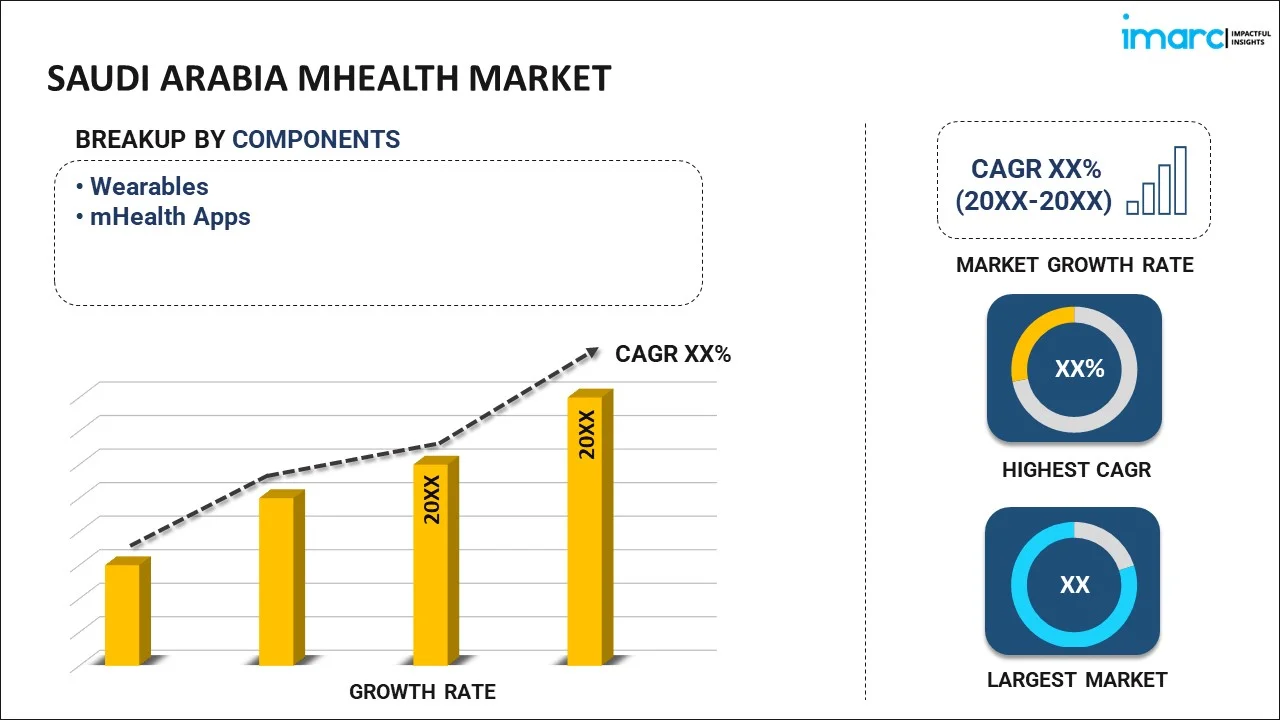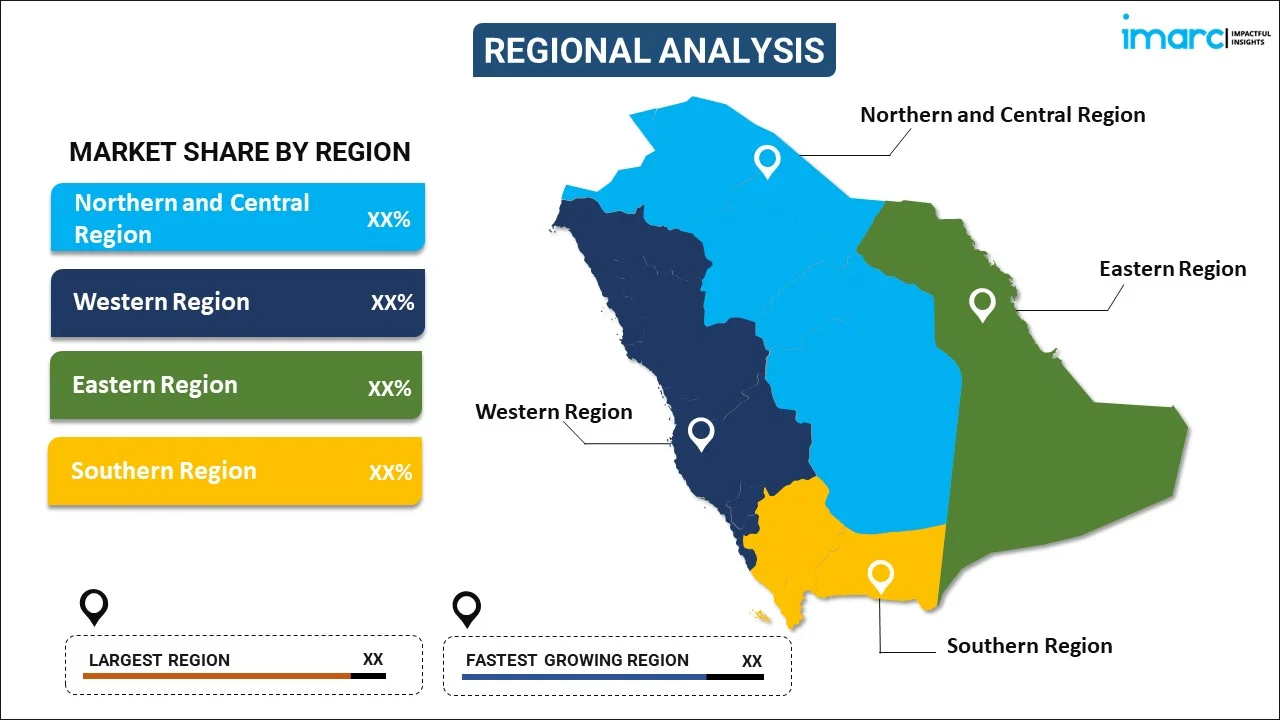
Saudi Arabia mHealth Market Report by Component (Wearables, mHealth Apps), Service (Monitoring Services, Diagnosis Services, Healthcare Systems Strengthening Services, Treatment Services, and Others), Participants (mHealth Application Companies, Pharmaceuticals Companies, Hospitals, Health Insurance Companies, and Others), and Region 2025-2033
Market Overview:
Saudi Arabia mHealth market size reached USD 1.0 Billion in 2024. Looking forward, IMARC Group expects the market to reach USD 4.8 Billion by 2033, exhibiting a growth rate (CAGR) of 17.2% during 2025-2033. The increasing proliferation of smartphones, a tech-savvy youthful population, government initiatives for healthcare digitization, the rising demand for remote patient monitoring, the COVID-19-induced surge in telemedicine, regulatory support, collaborative innovations, and growing focus on preventive healthcare represent some of the key factors driving the market.
|
Report Attribute
|
Key Statistics
|
|---|---|
|
Base Year
|
2024 |
|
Forecast Years
|
2025-2033
|
|
Historical Years
|
2019-2024
|
| Market Size in 2024 | USD 1.0 Billion |
| Market Forecast in 2033 | USD 4.8 Billion |
| Market Growth Rate (2025-2033) | 17.2% |
mHealth, short for mobile health, is a rapidly evolving field in healthcare that leverages mobile technologies, such as smartphones, tablets, and wearable devices, to deliver medical and health-related services. This encompasses a broad range of applications, including health information dissemination, remote patient monitoring, medication adherence, and mobile health interventions. mHealth capitalizes on the ubiquity of mobile devices to enhance healthcare accessibility, especially in remote or underserved areas, providing timely information and support. Patients can use mHealth apps to monitor vital signs, track fitness activities, receive medication reminders, and even consult with healthcare professionals through telemedicine platforms. The integration of mHealth into healthcare systems has the potential to improve health outcomes, increase efficiency, and empower individuals to actively manage their well-being. As technology continues to advance, the role of mHealth is expanding, contributing to the transformation of traditional healthcare delivery and fostering a more patient-centered and interconnected healthcare ecosystem.
Saudi Arabia mHealth Market Trends:
The increasing integration of mobile technologies into healthcare represents one of the prime factors driving the mHealth market in Saudi Arabia. Besides this, the widespread smartphone adoption in the country facilitating the accessibility of mHealth applications to a broad demographic is strengthening the market growth. The market is further influenced by the nation's youthful population, characterized by a tech-savvy inclination. Moreover, the government's emphasis on healthcare digitization, as part of its Vision 2030 initiative, has spurred investments and policies, creating a positive outlook for market expansion. In confluence with this, the growing need for improved healthcare access, especially in remote and underserved regions, leading to the expansion of mHealth services, bringing medical information and support to areas with limited traditional healthcare infrastructure, is bolstering the market growth. Concurrently, the rising prevalence of chronic diseases intensifying the demand for remote patient monitoring and management is providing an impetus to the market growth. In line with this, the COVID-19 pandemic has further enhanced the adoption of telemedicine and mHealth services as people seek remote consultations to minimize physical contact and enhance healthcare accessibility, thereby aiding in market expansion. Additionally, the convenience offered by mHealth apps for tasks such as appointment scheduling, prescription refills, and health record access is acting as another significant growth-inducing factor. Furthermore, favorable government initiatives and regulatory support, with the authorities recognizing the potential of mHealth in improving healthcare outcomes and reducing the burden on traditional healthcare systems, are presenting lucrative opportunities for market expansion. Apart from this, the increasing awareness among healthcare professionals and the general public about the benefits of mHealth has fostered a positive perception and acceptance of these technologies in the healthcare landscape, thus propelling the market forward.
Saudi Arabia mHealth Market Segmentation:
IMARC Group provides an analysis of the key trends in each segment of the market, along with forecasts at the country levels for 2025-2033. Our report has categorized the market based on component, service, and participants.
Component Insights:

- Wearables
- Blood Pressure Monitors
- Blood Glucometer
- Pulse Oximeter
- Neurological Monitors
- Others
- mHealth Apps
- Medical Apps
- Fitness Apps
The report has provided a detailed breakup and analysis of the market based on the component. This includes wearables (blood pressure monitors, blood glucometer, pulse oximeter, neurological monitors, and others) and mhealth apps (medical apps and fitness apps).
Service Insights:
- Monitoring Services
- Diagnosis Services
- Healthcare Systems Strengthening Services
- Treatment Services
- Others
A detailed breakup and analysis of the market based on the service also been provided in the report. This includes monitoring services, diagnosis services, healthcare systems strengthening services, treatment services, and others.
Participants Insights:
- mHealth Application Companies
- Pharmaceuticals Companies
- Hospitals
- Health Insurance Companies
- Others
The report has provided a detailed breakup and analysis of the market based on the participants. This includes mhealth application companies, pharmaceuticals companies, hospitals, health insurance companies, and others.
Regional Insights:

- Northern and Central Region
- Western Region
- Eastern Region
- Southern Region
The report has also provided a comprehensive analysis of all the major regional markets, which include Northern and Central Region, Western Region, Eastern Region, and Southern Region.
Competitive Landscape:
The market research report has also provided a comprehensive analysis of the competitive landscape. Competitive analysis such as market structure, key player positioning, top winning strategies, competitive dashboard, and company evaluation quadrant has been covered in the report. Also, detailed profiles of all major companies have been provided.
Saudi Arabia mHealth Market Report Coverage:
| Report Features | Details |
|---|---|
| Base Year of the Analysis | 2024 |
| Historical Period | 2019-2024 |
| Forecast Period | 2025-2033 |
| Units | Billion USD |
| Scope of the Report | Exploration of Historical and Forecast Trends, Industry Catalysts and Challenges, Segment-Wise Historical and Predictive Market Assessment:
|
| Components Covered |
|
| Services Covered | Monitoring Services, Diagnosis Services, Healthcare Systems Strengthening Services, Treatment Services, Others |
| Participants Covered | mHealth Application Companies, Pharmaceuticals Companies, Hospitals, Health Insurance Companies, Others |
| Regions Covered | Northern and Central Region, Western Region, Eastern Region, Southern Region |
| Customization Scope | 10% Free Customization |
| Post-Sale Analyst Support | 10-12 Weeks |
| Delivery Format | PDF and Excel through Email (We can also provide the editable version of the report in PPT/Word format on special request) |
Key Questions Answered in This Report:
- How has the Saudi Arabia mhealth market performed so far and how will it perform in the coming years?
- What has been the impact of COVID-19 on the Saudi Arabia mhealth market?
- What is the breakup of the Saudi Arabia mhealth market on the basis of component?
- What is the breakup of the Saudi Arabia mhealth market on the basis of service?
- What is the breakup of the Saudi Arabia mhealth market on the basis of participants?
- What are the various stages in the value chain of the Saudi Arabia mhealth market?
- What are the key driving factors and challenges in the Saudi Arabia mhealth?
- What is the structure of the Saudi Arabia mhealth market and who are the key players?
- What is the degree of competition in the Saudi Arabia mhealth market?
Key Benefits for Stakeholders:
- IMARC’s industry report offers a comprehensive quantitative analysis of various market segments, historical and current market trends, market forecasts, and dynamics of the Saudi Arabia mhealth market from 2019-2033.
- The research report provides the latest information on the market drivers, challenges, and opportunities in the Saudi Arabia mhealth market.
- Porter's five forces analysis assist stakeholders in assessing the impact of new entrants, competitive rivalry, supplier power, buyer power, and the threat of substitution. It helps stakeholders to analyze the level of competition within the Saudi Arabia mhealth industry and its attractiveness.
- Competitive landscape allows stakeholders to understand their competitive environment and provides an insight into the current positions of key players in the market.
Need more help?
- Speak to our experienced analysts for insights on the current market scenarios.
- Include additional segments and countries to customize the report as per your requirement.
- Gain an unparalleled competitive advantage in your domain by understanding how to utilize the report and positively impacting your operations and revenue.
- For further assistance, please connect with our analysts.
 Request Customization
Request Customization
 Speak to an Analyst
Speak to an Analyst
 Request Brochure
Request Brochure
 Inquire Before Buying
Inquire Before Buying




.webp)




.webp)












